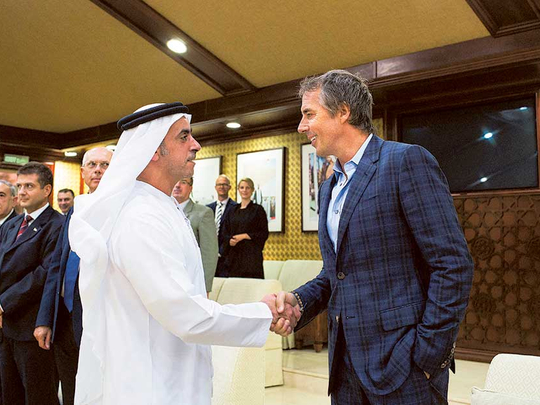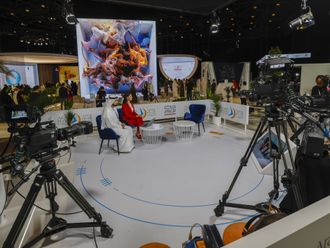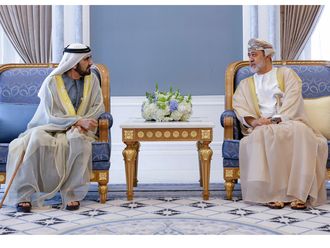
Abu Dhabi: Dan Buettner, National Geographic writer and explorer said on Wednesday he had studied the world’s “Blue Zones” communities where people live with vim and vigour to record-setting age to find out the secrets to living long and staying healthy.
During a talk at the majlis of His Highness Shaikh Mohammad Bin Zayed Al Nahyan, Abu Dhabi Crown Prince and Deputy Supreme Commander of the UAE Armed Forces, Buettner shared the nine common diet and lifestyle habits that help them live healthy well past the 100 year mark.
Buettner who has been studying the world’s longest-living peoples, said: “Elders of the communities of the world’s ‘Blue Zones’ live 10 to 12 healthy, robust active years longer than the rest of us. And they do it with a fraction of the chronic diseases. Our Blue Zones expedition team visited those places to try to determine what was helping them live so long.”
These Blue Zones areas of longevity are Okinawa, Ikaria, Sardinia, the Nicoya peninsula of Costa Rica.
According to him, if people from other regions across the world were able to mimic or establish lifestyles and environments like these Blue Zones cultures, they can create healthier places to work, play and live within their communities.
“The Danish twin studies established that about 80 per cent of how long you live is based on lifestyle and environment, the other 20 per cent is dependent mostly on genes and access to basic healthcare,” he said.
Buettner added if lifestyle, habits and environment account for 80 per cent of our longevity, he wanted to study pockets of people who were doing it right. “Through funding with National Geographic, we hired the best demographers to look at the data and found the five geographic locations where entire populations of people live exceptionally long — and have been doing so for decades and decades. The goal: if we can find the optimal lifestyle and environments for longevity we would have the de facto formula for longevity,” Buettner said.
He said remarkably, we see the same characteristics among the world’s longest-lived peoples, no matter where you go. “We call these characteristics the Power 9.”
Buettner explained one thing common among these cultures is constant movement. “People in the Blue Zones areas don’t run marathons or do hot yoga. They move throughout the day by walking, gardening and chopping wood. They wake up with a sense of purpose and could articulate it in what we might call a personal mission statement. Each day they take time to unplug and de-stress and downshift. It can be meditating, napping or spending time in nature.
“People in the Blue Zones also eat wisely: They eat smaller portions and next to no processed food.
“Essentially, they stop eating when they are about 80 per cent full. They eat plant slant of mostly vegetables, grains and fruit. They are not pure vegetarians, but they typically eat meat about three times a month mostly during holidays and celebrations.”
He said these people belong, they spend more time socialising than we do — and it’s not on Facebook, Twitter or texting. “Face to face time with people matters. They have a strong sense of faith and attend religious services. All but a handful of centenarians that we interviewed belonged to a faith-based community. Family and loved ones matter — their right tribe. They keep their ageing parents close, they have monogamous healthy spousal relationships, and they nurture children.
“Spending time with family and close friends, especially across generations, contributes to health, longevity and success of all the family members,” he said.
Explaining how we can create these types of environments in our own homes and communities, Buettner said research showed most people spend 80 per cent of their lives within 32km of their homes, so his programme focuses on that immediate environment:
“Number one is policy. When a community changes their policies to be more focused on wellness, that is the most significant long-term impact for the community and though it can sometimes take time to push policy changes through, it’s one of the least expensive interventions. Next is the built environment: are there roads and parks and paths that make it easy to walk downtown?”
Buettner added we know that in the Blue Zones, friends really matter. “The Framingham research showed that obesity, smoking, happiness and depression spread from a person to person-through social networks, much like a virus during an epidemic. People need fun, interesting activities to enjoy with their friends. A community or workplace campus that provides interesting places to play and be active or inspire curiosity and learning adds exponentially to the well-being of its members. Since we know that social networks are contagious we look for ways to connect like-minded people.”
Buettner said people as individuals make over 150 health-related decisions a day and need to have healthy choices that are readily available and easy to make without thinking about it in work-places, schools, restaurants, grocery stores and homes.
According to Buettner, while there is no one answer for improving health and well-being, this systematic model focuses on the most important aspects of the environment so the healthy choice just naturally ensues. “It’s the culmination of small changes that over time make the biggest impact on health,” he said.











